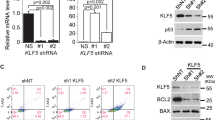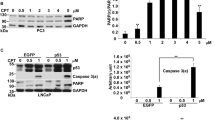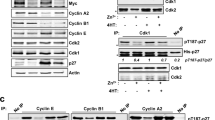Abstract
Transcriptional activation and stabilization of p53 is a major response of mammalian cells to U.V.-light induced genetic damages, and possibly responsible for cell damage control. We have studied here by gel mobility shift and immunoblotting assays the activation and accumulation of p53 by U.V.C. and its dependency on cell cycle, protein synthesis and protein phosphorylation. In G0/G1 synchronized cells U.V.C.-induced p53 DNA-binding activity, but not its accumulation, whereas both events took place in G1/S and S-phase cells. The kinetics of p53 activation by U.V.C. were slow requiring at least 1 h and slowly increasing thereafter with full activation observed at 6 h. Treatment of cells with cycloheximide (CHX) prevented the activation of p53 in all phases of the cell cycle and its accumulation in G1/S and S. However, removing CHX-block allowed full activation and accumulation of p53 with fast kinetics even if 4 h had lapsed since the initial U.V.C. insult. This suggests that the protein synthesis-dependent signal initiating p53 activation by U.V.C. remains continuous in the cells. The requirement of protein phosphorylation as mediator of p53 activation by U.V.C. was studied by using chemical protein kinase inhibitors. Of the tested inhibitors, only staurosporine, a known inhibitor of protein kinase C (PKC) and various other kinases, inhibited both p53 activation and accumulation, whereas specific PKC inhibitors, tyrosine kinase inhibitors and a serine/threonine kinase inhibitor did not. PKC-mediation of the p53 U.V.-response was further ruled out by the reactivity of the activated p53 to C-terminal antibody PAb 421. Kinetic studies showed that staurosporine-mediated inhibition of p53 function is an early event in cell damage response. Thus dual, kinetically different events, de novo protein synthesis and staurosporine-inhibited protein phosphorylation are required for p53 activation and accumulation in all phases of the cell cycle. Notably, in the absence of U.V.-induced accumulation in G0/G1 cells, p53 activation is still subject to inhibition of protein synthesis.
This is a preview of subscription content, access via your institution
Access options
Subscribe to this journal
Receive 50 print issues and online access
$259.00 per year
only $5.18 per issue
Buy this article
- Purchase on Springer Link
- Instant access to full article PDF
Prices may be subject to local taxes which are calculated during checkout
Similar content being viewed by others

Author information
Authors and Affiliations
Rights and permissions
About this article
Cite this article
Pitkänen, K., Haapajärvi, T. & Laiho, M. U.V.C.-Induction of p53 activation and accumulation is dependent on cell cycle and pathways involving protein synthesis and phosphorylation. Oncogene 16, 459–469 (1998). https://doi.org/10.1038/sj.onc.1201528
Received:
Revised:
Accepted:
Published:
Issue Date:
DOI: https://doi.org/10.1038/sj.onc.1201528
Keywords
This article is cited by
-
Unmasking of phosphorylation-sensitive epitopes on p53 and Mdm2 by a simple Western-phosphatase procedure
Oncogene (2000)
-
Ras induces p21Cip1/Waf1 cyclin kinase inhibitor transcriptionally through Sp1-binding sites
Oncogene (1999)
-
p53 accumulation in apoptotic macrophages is an energy demanding process that precedes cytochrome c release in response to nitric oxide
Oncogene (1999)


